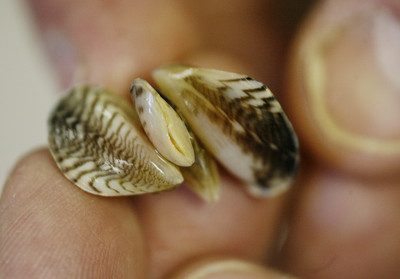Mussels munching on pipe pulled from Lake Mead
Only one item is on the menu, but you don't get to be an invasive pest by being finicky.
It took just two months for quagga mussels to find and colonize a piece of pipe that was submerged in Lake Mead as part of a test by the regional Clean Water Coalition.
The 15-foot-long pipe was pristine when it was sunk in about 110 feet of water in November. When it was pulled from Boulder Basin late last month, it already was speckled inside and out with juvenile quaggas no bigger than a grain of sand.
In places, the infestation resembled a coarse layer of stucco.
The results of the taste test were unequivocal.
"They like the material," said Doug Karafa, general manager of the Clean Water Coalition.
The pipe has been returned to the deep, where it will remain until it is rechecked at the six-month mark and again after one year in the water.
The goal is to determine how quickly quagga mussels will collect on the type of polyethylene pipe the coalition plans to use for its new sewage outfall system at Lake Mead.
Construction is slated to begin this summer on the $150 million project. When it is finished, most likely in late 2012 or early 2013, it will carry up to 200 million gallons of treated effluent to the bottom of Lake Mead, where it will be released into the water through a network of emitters.
Right now, the valley's treated wastewater -- roughly 180 million gallons of it a day -- is dumped into the Las Vegas Wash to flow downstream to Lake Mead.
Karafa said results of the pipe test will help the coalition of sewer agencies in Clark County, Las Vegas, Henderson and North Las Vegas determine how best to deal with quaggas.
One approach may involve coating the pipes with a substance that repels the mussels or makes them easier to clean off.
The U.S. Bureau of Reclamation is in the midst of a broader study of various materials, coatings and countermeasures aimed at keeping quaggas out of pipes, power plant cooling systems and marine equipment.
So far, "We're finding they're pretty much liking everything," bureau spokesman Peter Soeth said.
Researchers also found that the nonnative mussels behave quite differently in the Colorado River system than they do in the Great Lakes, where they first arrived about 20 years ago as stowaways in ballast water of ships from eastern Europe and the Ukraine.
Each mussel is no bigger than a man's thumbnail, but their dense and fast-growing colonies have caused billions of dollars in damage and preventive maintenance costs in the Great Lakes region and elsewhere in the Midwest and eastern United States.
Left unchecked, they can clog water supply pipelines, power plant cooling systems and marine equipment.
Until January 2007, when they turned up in Lake Mead, quagga mussels had never been found west of the Mississippi River. Since then, the bivalve mollusk with the striped shell has turned up in lakes Mohave and Havasu downstream from Hoover Dam, in water systems in California and most recently in two Utah lakes.
Quaggas multiply rapidly, with a single female laying as many as 1 million eggs. They can completely plug pipes up to 12 inches in diameter and restrict flow in larger pipes. Their colonies also can speed the corrosion of pipes and other underwater infrastructure.
The Clean Water Coalition's pipe test is being conducted with help from researchers at the University of Nevada, Las Vegas and staff at Las Vegas Boat Harbor.
They also are testing pipe floating on the surface of Lake Mead to see how it is affected by mussels and other factors such as sunlight and changes in temperature.
But switching to a different kind of pipe -- one that quaggas don't like quite so much -- isn't really an option, Karafa said.
"The beauty of polyethylene is that it's flexible, because we're laying it across the bottom of the lake," he said.
Karafa said their project has one thing going for it. The outfall system will be pushing water into Lake Mead, not sucking it out, so they might be able to keep quaggas out of their pipes through water pressure alone.
Contact reporter Henry Brean at hbrean @reviewjournal.com or 702-383-0350.


















